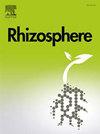不同的次生生长模式与根瘤的演化起源:巨叶竹、相思与台湾桤木根瘤的形态解剖学比较分析
IF 3.5
3区 生物学
Q1 PLANT SCIENCES
引用次数: 0
摘要
大叶竹、相思和台湾桤木的根瘤在初生期具有相似的形态和解剖结构;然而,在二次生长期间观察到显著差异。巨叶竹根瘤的次生结构是由次生分生组织发育而来,而马相思和台湾桤木根瘤的次生结构是由初生分生组织发育而来。在大叶竹和台湾桤木中,根瘤中的细菌区围绕维管组织,而在相思中,细菌区位于相反的一侧。根瘤菌和根瘤菌主要分布区域的差异导致了巨叶竹根瘤含菌区的分层。豆科根瘤菌根瘤和非豆科根瘤菌根瘤可能是从豆科根瘤菌根瘤进化而来的。本文章由计算机程序翻译,如有差异,请以英文原文为准。
Divergent secondary growth patterns and evolutionary origins of root nodules: a comparative morpho-anatomical analysis of root nodules in Podocarpus macrophyllus, Acacia mangium, and Alnus formosana
The morphological and anatomical structures of root nodules in Podocarpus macrophyllus, Acacia mangium, and Alnus formosana exhibited similarities during the primary growth stage; however, significant differences were observed during secondary growth. The secondary structures of root nodules in Podocarpus macrophyllus developed from secondary meristems, while those in Acacia mangium and Alnus formosana originated from the primary meristems. In Podocarpus macrophyllus and Alnus formosana, the bacterial zones in the root nodules surround the vascular tissue, whereas in Acacia mangium, the bacterial zones are located on the opposite side. The stratification of bacteria-containing areas in the root nodules of Podocarpus macrophyllus resulted from variations in the primary distribution zones of Rhizobia and Frankia. The legume-Rhizobia and nonlegume-Frankia root nodules may have evolved from Podocarpaceae–Rhizobia–Frankia nodules.
求助全文
通过发布文献求助,成功后即可免费获取论文全文。
去求助
来源期刊

Rhizosphere
Agricultural and Biological Sciences-Agronomy and Crop Science
CiteScore
5.70
自引率
8.10%
发文量
155
审稿时长
29 days
期刊介绍:
Rhizosphere aims to advance the frontier of our understanding of plant-soil interactions. Rhizosphere is a multidisciplinary journal that publishes research on the interactions between plant roots, soil organisms, nutrients, and water. Except carbon fixation by photosynthesis, plants obtain all other elements primarily from soil through roots.
We are beginning to understand how communications at the rhizosphere, with soil organisms and other plant species, affect root exudates and nutrient uptake. This rapidly evolving subject utilizes molecular biology and genomic tools, food web or community structure manipulations, high performance liquid chromatography, isotopic analysis, diverse spectroscopic analytics, tomography and other microscopy, complex statistical and modeling tools.
 求助内容:
求助内容: 应助结果提醒方式:
应助结果提醒方式:


